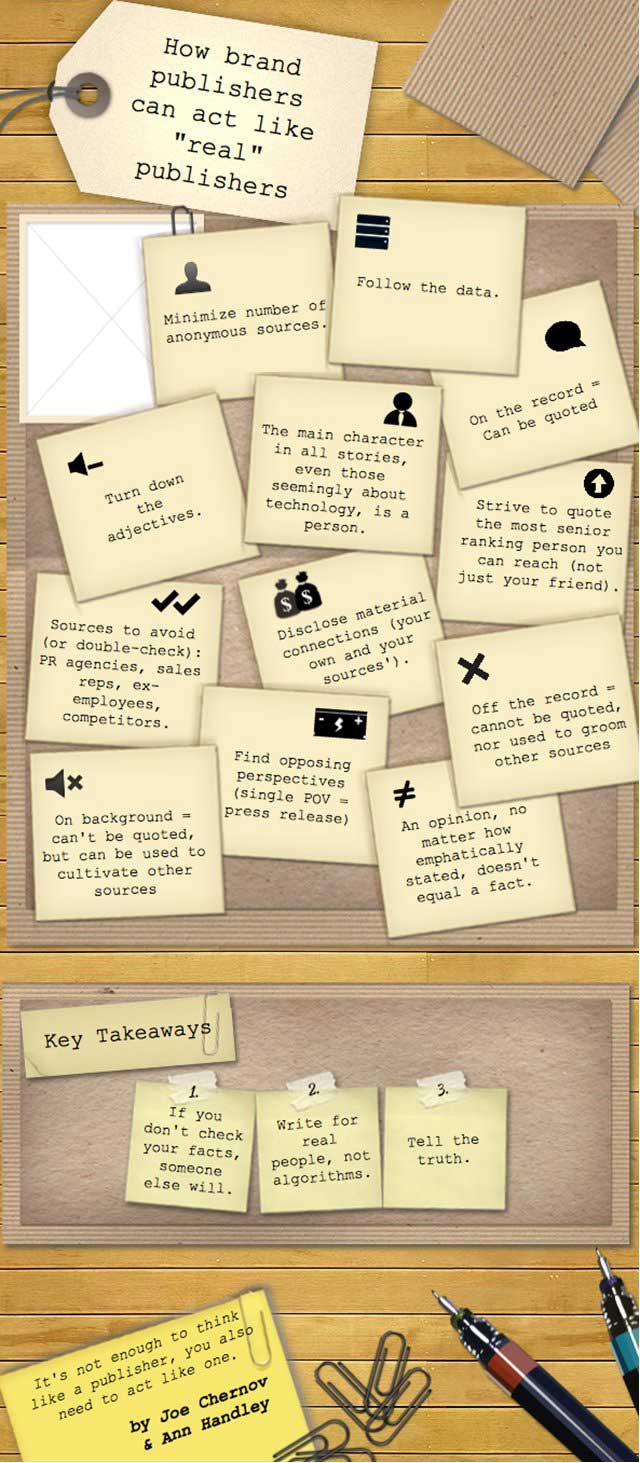Marketing is a fun place to be these days, isn't it? New tools and new technologies and new platforms are giving businesses interesting opportunities to connect with customers in inherently more meaningful ways.
Of course, that's put new pressure on marketers and layered new requirements onto Marketing. Our newly social Web is requiring brands to bulk up their content creation muscles and inject themselves with a kind of social steroid.
It's not enough to simply be creating content—to be publishing blogs and newsletters, and producing webinars and podcasts. Instead, brands have to be consistently creating and sharing really great stuff—not just stuff that's merely good enough.
In content marketing these days, either you rock or you suck. This new era isn't about storytelling; it's about telling a true story well.
Brand Journalism on the Rise
Some companies are looking toward traditional journalism to fill the gaping content maw, hiring those trained in J-school tactics like reporting and storytelling as in-house "brand journalists."
A brand journalist or corporate reporter works inside the company, writing and producing videos, blog posts, photos, webinars, charts, graphs, e-books, podcasts, and other information that delivers value to your marketplace.
Such content creators will convey your company's true story in a compelling way by uncovering the stories about your brand and how your customers are using your products and services; narrating them in a human, accessible way; and sparking conversation about your company, customers, or employees.
In other words, brand journalists bring a reporter's sensibility to your content. They bring an editorial approach to building a brand. Two years ago, Eloqua hired Jesse Noyes from the Boston Business Journal to cover issues related to its business. Others—like Boeing, Home Depot, Radian6, and the Florida Travel and Tourism Board—have hired journalists to either head up or contribute to the content charge. I've detailed in the past why I like this approach.
Marketers newly charged as creators of different kinds of content can learn a lot from the world of journalism. It's not enough for brands to think like a publisher. You also need to act like one. But, lately, I've noticed a lot of companies assuming that we're-all-publishers-now mantra without a clear understanding of the ground rules.
Last week, I noticed that another company had co-opted some content that MarketingProfs had created, scrubbed it free of our branding and other identifiers, and then passed it off as their own. This sort of thing happens all the time on the Web, I know: Bots consistently scrape content and republish it elsewhere with no regard for copyright or ownership.
But this situation was a little different for me, because the piece that was lifted was something our team was particularly proud of, having invested many hours in creating what we thought was nothing short of brilliant (and, incidentally, it also effectively drove business for us). The steal felt like more of an ethical violation than a straight copyright issue, in other words. And it felt more personal because it was a theft of an idea that we had spent many hours honing, vs. a cut-and-paste of, say, a blog post.
I started out this piece talking up the inherent opportunity—and content creation and social media are an opportunity... a huge one, in fact. But, at the same time, when it's done incorrectly—as I felt it had been by the co-opter last week—it's a potentially huge fail that could tick people off... but also damage your reputation, your brand, and your business.
The Same Standards as Traditional Publishers
Which leads me to this: Brand publishers must adhere to the same basic editorial standards as traditional media. (See infographic at the end of this article.)
Companies can't adopt the "everyone is a publisher" mantra without a broader awareness of what it means to use content to build an audience, and they can't cherry-pick the most "fun" parts of being a publisher and discard time-honored editorial processes. Here are some guidelines, devised by me in conjunction with Joe Chernov, VP of Content Marketing at Eloqua, who shares this sensibility with me:
- Tell the truth. Feature real people, real situations, genuine emotions, and facts (more about that in a minute). As much as possible, your content should show, not tell. It should show your product as it exists in the world, through customer stories, case studies or client perspectives and narratives. How do you add value? Why do you matter? That is your story.
- Use data. Data puts your content in context and gives you credibility. Ground your content in facts: Data, research, and numbers are the foundation for any story. Your ideas and opinions and spin might be part of that story—or they might not be, depending on what you are trying to convey. But the more credible content is rooted in something real, not just your own beliefs.
Said another way: data before declaration. In other words, if you are going to tell me what you think, give me a solid reason why you think it. - Cite sources. Give credit where credit is due: If you use an infographic from another company, cite the source and link to it. If you create that infographic based on someone else's data, say that, too, Joe wrote in a piece in Mashable. Also, if you interview someone and use what he says either directly or indirectly, attribute the ideas to that person, even if you don't use his exact words. (Like I just did that in this paragraph.)
- Seek out the best sources, and know the difference between "on the record,"
"for background," and "off the record." Newspaper reporters go to the scene of an incident to report what really happened; in the business world, you should, too. Are you blogging about a new technology? Talk to the guy who developed it, not the PR or marketing person promoting it. My newspaper editors used to tell me this: Find the person standing as closest to the center of a story as you can. - Check your spelling. It pains me to have to say this, but my name gets botched all the time in social media, and I see others suffering a similar fate. Make sure you double-check proper name and company names and use them consistently correctly. Otherwise, your work appears sloppy, and you risk losing credibility. Said another way: My first name does not have an E at the end of it, and my last name, "Handley," has a D in the center of it. Dig?
- Root out opposing viewpoints. As Joe Chernov says, "There's a name for something with a single point of view: It's called a press release." Incorporate multiple perspectives when the issue lends itself to that. At the very least, don't ignore the fact that other points of view might exist; to do so makes me not trust you.
- Be aware of hidden agendas. If you interview a source, be clear on what agenda is behind their point of view. In business, often that means you should follow the money: Who butters their bread? Are they a competitor? Investor? PR professional retained to maintain a specific point of view? They might still be credible as a source—in fact, PR folks can be awesome background sources—but you need to be aware of any agenda.
- Edit. At newspapers and magazines, editors are the bottom line in what gets said and where it gets said and how long a publication will dedicate to saying it. Brands need to adopt a similar economy to the content they produce and focus on producing the very best stuff in the very best way they possibly can.
- Keep things simple. Business—like life—can be complicated. Products can be involved or seem impenetrable. But your content should deconstruct the complex to make it easily understood: Lose the corporate Frankenspeak and convey what you want to say in human, accessible terms. I first learned this from my journalism professors: Assume the reader knows nothing. But don't assume the reader is stupid.
- Think visually. The visual Web is the norm—so consider how you might add visual elements to any story you tell.
Bonus Rule: Make your customer the hero of your story. The best content has a human element to it. Why? Because your readers are people, which means they will relate better to your story if you relate it to them on their level. Even if you sell something inherently boring like technology or toasters, focus on how your products or services touch people's lives.
By the way, when you are talking about people, a good rule of thumb is this: Be specific enough to be believable and universal enough to be relevant.
Which is a good rule for content, and for life.
Big thanks to Eloqua's Joe Chernov (@jchernov) for his help with this write-up.
Download or embed the following infographic via Slideshare:





